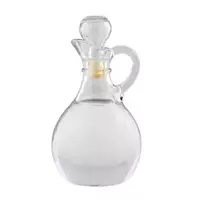Vinegar 3%

Researchers found written references to the use of vinegar in cooking, dating back to 5000 BC. In ancient Babylon, vinegar was widely used for culinary purposes. Vinegar can be called the oldest product that was obtained as a result of microbiological synthesis. Some researchers believe that vinegar man invented much earlier than wine, which is mentioned in the Old Testament of the Bible.
Vinegar is a product that contains a large amount of acetic acid. Vinegar is traditionally obtained by natural microbiological synthesis during which acetic acid bacteria develop in gold-containing raw materials. Vinegar refers to the category of spices and seasonings that have been known to humans since ancient times. Over the millennia of vinegar, enough product recipes have been invented.
Among the most common types of vinegar are the following: apple cider vinegar, balsamic, wine, malt, rice, alcohol, milk whey vinegar. Besides, one produces vinegar flavoured with fragrances, basil, garlic, dill, thyme, tarragon, pepper, as well as parsley. For culinary purposes, the so-called table vinegar is used 3% -15%.
Table vinegar 3% can be purchased ready-made in most domestic grocery stores. If there is no finished product at hand, you can dilute acetic essence with water at home and get vinegar 3%. However, it is worth remembering that acetic essence contains up to 80% acetic acid in its composition.
If you do not comply with the correct proportions, you risk getting not table vinegar 3%, but a concentrated product dangerous for the stomach. So 100 ml of 70% acetic essence contained 70 ml of acetic acid and 30 ml of water. It is necessary to reduce the concentration of acetic acid in 100 ml of essence so as to obtain vinegar with 3%, and not with 70% of the acid content in the composition. To get vinegar 3% follow the proportion - 70/3 * 100 ml.
The calculation resulted in 2333 ml - just as much water should be added to 100 ml of acetic essence to get vinegar 3%. Similar calculations are used to obtain vinegar 6% and 9%. Table vinegar 3% is used in cooking as a spice, as well as a taste additive when preparing salads, as well as first courses and snacks. Vinegar is used in the process of preservation of various products.
In addition, vinegar is considered important ingredients when making homemade mayonnaise, as well as some classic sauces. Often vinegar is used to make marinades, as well as drinks. Vinegar is considered a means of traditional medicine, and is also used in the pharmaceutical industry.
vinegar 3% 11 kCal
The energy value of vinegar is 3% (Ratio of proteins, fats, carbohydrates - ju):
Proteins: 0 g (~ 0 kCal)
Fats: 0 g (~ 0 kCal)
Carbohydrates: 3g (~ 12kCal)
Energy ratio (bj | y): 0% | 0% | 109%
 Español
Español Français
Français Português
Português Русский
Русский 简体中文
简体中文 繁體中文
繁體中文 日本語
日本語 한국어
한국어 العربية
العربية Türkçe
Türkçe Қазақ
Қазақ Deutsch
Deutsch Italiano
Italiano Українська
Українська
